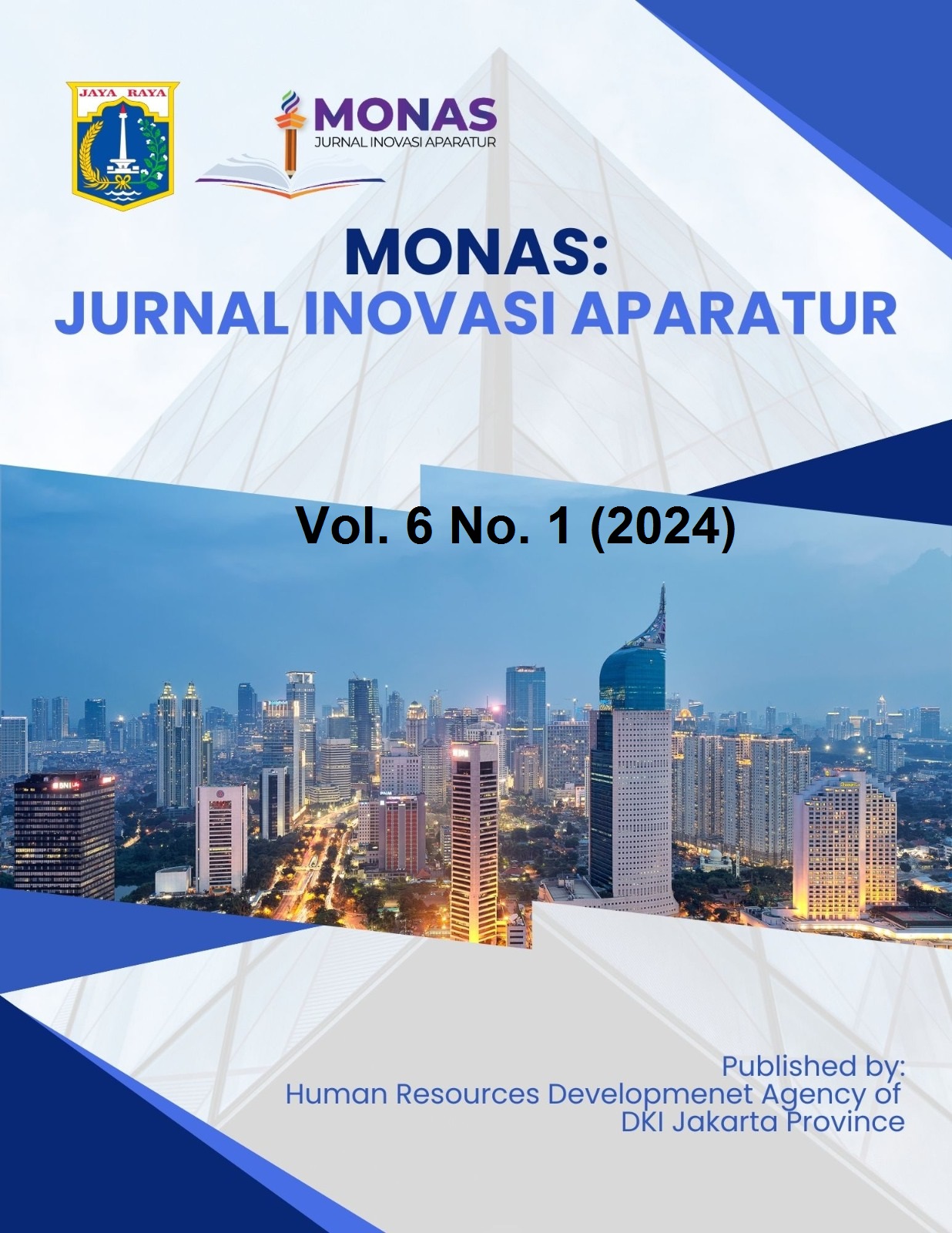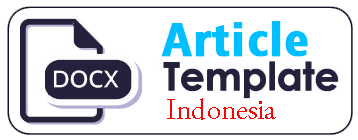Implementation of Adaptive Core Value
Review of Bali Province CPNS BKPSDM Learning Process in 2022
DOI:
https://doi.org/10.54849/monas.v6i1.178Keywords:
Training, Adaptive Core Values, Adaptive Performance ProfileAbstract
This research aims to describe how the Adaptive Core Value learning process can explain the Adaptive performance profile of Basic Training participants for Agenda II Civil Servant Candidates using the classical training model. The learning process for participants aims to understand the concept of Adaptiveness and actualize adaptive values in carrying out their job duties. From the concept findings and implementation, the learning process achieved will be put into practice and described; in addition to that, an instrument will be developed to see the participant's adaptive performance profile. This research used descriptive quantitative and qualitative methods with purposive random sampling involving participants from Batch I and XVII of 2022 at the Personnel and Human Resources Development Agency of Bali Province. The results of the book review found that the Adaptive Core Value concept leads to adaptive performance, which contains the dimensions: 1) handling emergency/crisis situations; 2) managing work stress; 3) solving problems creatively; 4) facing an uncertain work situation; 5) training and learning efforts; 6) interpersonal adaptation; 7) work culture adaptation; and 8) physical adaptation. The findings in this research show that all dimensions of Adaptive performance have emerged in the learning process in Adaptive training courses. In line with this, the participant's Adaptive performance profile is high. Thus, there is a match between the achievements in the learning process and the participants' adaptive performance profiles. Learning is not limited to concepts and theories but how they can actualize these Adaptive values in the form of Adaptive performance in the learning process. It is hoped that the results of this research can be a reference in learning Agenda II Core Values of ASN with AKHLAK on Adaptive values and can develop other Core Values of ASN with AKHLAK.
References
Allworth, E. A., & Hesketh, B. (1996). Construct-based biodata and the prediction of adaptive performance. Twelfth Annual Conference of the Society for Industrial and Organizational Psychology. St. Louis, MO.Barbara Griffin, B. H. (2005). Are conscientious workers adaptable? Australian Journal of Management, 30(2), 245–259.
Becker, N., Becker, S., Egbers, A., Höke, L., Möllers, M., Pfeifer, A., & Wöbkenberg, C. (2018). Goal orientation and performance adaptation: A meta-analysis. https://www.journals.elsevier.com/journal-of-research-in-personality
Charbonnier-Voirin, A., & Roussel, P. (2012). Adaptive performance: A new scale to measure individual performance in organizations. Canadian Journal of Administrative Sciences, 29(3), 280–293. https://doi.org/10.1002/CJAS.232
Coleman, V. I. . , & B. W. C. (2000). Investigating the Underlying Structure of the Citizenship Performance Domain. Human Resource Management Review, 10(1), 25–44.
DfE: Teachers’ Standards, July .2011: https://bit.ly/30gg3mh
Elaine D. Pulakos, Neal Schmitt, David W. Dorsey, Sharon Arad, Walter C. Borman, & Jerry W. Hedge. (2002). Predicting Adaptive Performance: Further Tests of a Model of Adaptability. Https://Www.Tandfonline.Com/Journals/Hhup20, 15(4), 299–323.
Gilad Chen, Brian Thomas, & J Craig Wallace. (2005a). A multilevel examination of the relationships among training outcomes, mediating regulatory processes, and adaptive performance. Journal of Applied Psychology, 90(5), 827–841.
Gilad Chen, Brian Thomas, & J Craig Wallace. (2005b). A multilevel examination of the relationships among training outcomes, mediating regulatory processes, and adaptive performance. Journal of Applied Psychology, 90(5), 827–841.
Griffin, M. A., Neal, A., & Parker, S. K. (2007). A new model of work role performance: Positive behavior in uncertain and interdependent contexts. Academy of Management Journal, 50(2), 327–347. https://doi.org/10.5465/AMJ.2007.24634438
Han, T. Y., & Williams K. J. (2008). Multilevel investigation of adaptive performance: Individual and team level relationships. Group & Organization Management, 33(6), 657–684.
Hesketh, B., & Neal, A. (1999). Technology and performance. In D.R. Ilgen & D.P. Pulakos (Eds.), The changing nature of performance: Implications for staffing, motivation and development (pp. 21–55). San Francisco: Jossey-Bass.
Hollenbeck, J. R., LePine, J. A., & Ilgen, D. R. (1996). Adapting to roles in decision making teams. In K.R. Murphy (Ed.), Individ-ual differences and behavior in organizations (pp. 300–333). San Francisco, CA: Jossey-Bass
Johnson, J. W. (2001). The relative importance of task and contextual performance dimensions to supervisor judgments of overall performance. Journal of Applied Psychology, 86(5), 984–996. https://doi.org/10.1037/0021-9010.86.5.984
Ilgen, D. R. (1994). Jobs and roles: Accepting and coping with the changing structure of organizations. In M. G. Rumsey, C. B. Walker & J. H. Harris (Eds.), Personnel selection and classi-fication (pp. 13–22). Hillsdale, NJ: Erlbaum.
Indri, Des Prihantony. 2020. The Effectiveness Of Games Learning Method In National Defense Preparedness Subject On Basic Training For Civil Servant Candidates. Monas: Jurnal Inovasi Aparatur Vol 2 No 1 (2020): 124 – 134. DOI: https://doi.org/10.54849/monas.v2i1.36
Jundt, D. K., Shoss, M. K., & Huang, J. L. (2015). Individual adaptive performance in organizations: A review. Journal of Organizational Behavior, 36(S1), S53–S71. https://doi.org/10.1002/job.1955
Kusyadi, Y. (2020). Career Adaptability In Various Theories: Review Through Multicultural Perspectives. In JOMSIGN: Journal of Multicultural Studies in Guidance and Counseling (Vol. 4, Issue 1). APA.
LAN RI, 2022;. Salinan KepLAN Nomor: 13/K.1/PDP.07/2022 Tentang Pedoman Penyelenggaraan Pelatihan Dasar Calon Pegawai Negeri Sipil
LAN-RI. (2022). KepLAN Nomor 14/K.1/PDP.07 tentang Kurikulum Pelatihan Dasar Calon Pegawai Negeri Sipil (pp. 1–53). Lembaga Administrasi Negara RI.
LePine, J. A., Colquitt, J. A., & Erez, A. (2000). Adaptability to changing task contexts: Effects of general cognitive ability, Conscientiousness, and Openness to Experience. 53(3), 563–593.
Logan, M. S., & Ganster, D. C. (2007). The Effects of Empowerment on Attitudes and Performance: The Role of Social Support and Empowerment Beliefs. Ournal of Management Studies, 44(8), 1523–1550.
London, M., & Mone, E. M. (1999). Continuous Learning. In D. R.Ilgen & D. P. Pulakos (Eds.), The changing nature of perfor-mance: Implications for staffing, motivation and development (pp. 119–153). San Francisco: Jossey-Bass.
Murphy, P. R., & Jackson, S. E. (1999). Managing work role performance: Challenges for twenty-first-century organiza-tions and their employees. In D. R. Ilgen & D. P. Pulakos (Eds.), The changing nature of performance: Implications for staffing, motivation and development (pp. 325–365). San Francisco: Jossey-Bass.
SE MenpanRB No. 20 Tahun 2021 Tentang Implementasi Core Values dan Employer Branding Aparatur Sipil Negara, (2021).
Park, S., & Park, S. (2019). Employee Adaptive Performance and Its Antecedents: Review and Synthesis. In Human Resource Development Review (Vol. 18, Issue 3, pp. 294–324). SAGE Publications Ltd. https://doi.org/10.1177/ 1534484319836315
Pulakos, E. D., Arad, S., & Plamondon, K. E. (2000). Adaptability in the workplace: Development of a taxonomy of adaptive performance. Journal of Applied Psychology, 85(4), 612–624.
Pulakos, E. D., Dorsey, D. W., & White, S. S. (2006). Adaptability in the Workplace: Selecting an Adaptive Workforce. Emerald Group Publishing Limited, 6, 41–71.
Spreitzer, G. M. (n.d.). Toward the integration of two perspectives: A review of social-structural and psychological empowerment at work. https://www.researchgate.net/publication/228915522
Sternberg, R. J. (2019). A theory of adaptive intelligence and its relation to general intelligence. Journal of Intelligence, 7(4). https://doi.org/10.3390/jintelligence7040023
Stone-Romero, E. F., Alvarez, K., & Thompson, L. F. (2009). The construct validity of conceptual and operational definitions of contextual performance and related constructs. Human Resource Management Review, 19(2), 104–116. https://doi.org/10.1016/j.hrmr.2008.10.003
van der Vegt, G. S., van de Vliert, E., & Huang, X. (2005). Location-level links between diversity and innovative climate depend on national power distance. Academy of Management Journal, 48(6), 1171–1182.
Downloads
Published
Issue
Section
License
Authors who publish in this journal agree to the following terms:
- Authors retain copyright and grant the journal right of first publication with the work simultaneously licensed under a Creative Commons Attribution-NonCommercial-ShareAlike 4.0 International License that allows others to share the work with an acknowledgement of the work's authorship and initial publication in this journal.
- The journal allows the authors to hold the copyright without restrictions and to retain publishing rights without restrictions.
- Authors can enter into separate, additional contractual arrangements for the non-exclusive distribution of the journal's published version of the work (e.g., post it to an institutional repository or publish it in a book), with an acknowledgement of its initial publication in this journal.








